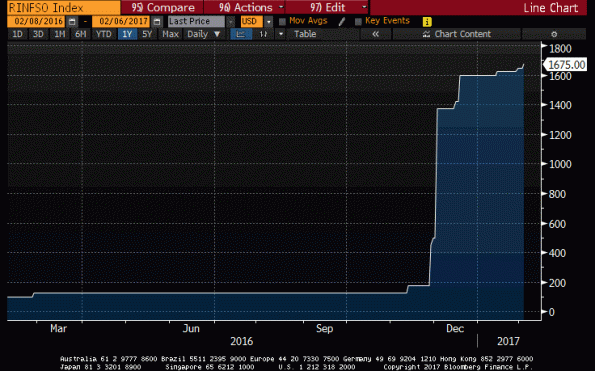Entering The RINF Cycle
Because I write a lot about inflation – we all have our spheres of expertise, and this is mine – I am often asked about how to invest in the space. From time to time, I’ve commented on relative valuations of commodities, for example, and so people will ask how I feel about GLD, or whether USCI is better than DJP, or whether I like MOO today. I generally deflect any inquiry about my specific recommendations (years of Wall Street compliance regimes triggers a nervous tic if I even think about recommending a particular security), even though I certainly have an opinion about gold’s relative value at the moment or whether it is the right time to play an agriculture ETF.
But I don’t mind making general statements of principle, or an analytical/statistical analysis about a particular fund. For example, I am comfortable saying that in general, a broad-based commodity exposure offers a better long-term profit expectation than a single-commodity ETF, partly because of the rebalancing effect of such an index. In 2010 I opined that USCI is a smarter way to assemble a commodity index. And so on.
When it comes to inflation itself, however, the answers have been difficult because there are so few alternatives. Yes, there are dozens of TIPS funds – which are correlated each to the other at about 0.99. But even these funds and ETFs don’t solve the problem I am talking about. TIPS allow you to trade real interest rates; but when inflation expectations rise, real interest rates tend also to rise and TIPS actually lose value on a mark-to-market basis. This can be frustrating to TIPS owners who correctly identify that inflation expectations are about to rise, but lose because of the real rates exposure. What we need is a way to trade inflation expectations themselves.
When I was at Barclays, we persuaded the CME to introduce a CPI futures contract, but it was poorly constructed (my fault) and died. Inflation swaps are available, but not to non-institutional clients. Institutional investors can also trade ‘breakevens’ by buying TIPS and shorting nominal Treasuries, since the difference between the nominal yield and the real yield is inflation expectations. But individual investors cannot easily do this. So what is the alternative for these investors? Buy TIP and marry it with an inverse Treasury ETF? The difficulties of figuring (and maintaining) the hedge ratio for such a trade, and the fact that you need two dollars (and double fees) in order to buy one dollar of breakeven exposure in this fashion, makes this a poor solution.
There have been attempts to fill this need. Some years ago, Deutsche Bank launched INFL, a PowerShares ETN that was tied to an index consisting of several points on the inflation-expectations curve. That ETN is now delisted. ProShares at about the same time introduced UINF and RINF, two ETFs that tracked the 10-year breakeven and 30-year breakeven rate, respectively. UINF was delisted, and RINF struggled. I lamented this fact as recently as last March, when I observed the following:
“Unfortunately, for the non-institutional investor it is hard to be long breakevens. The CME has never re-launched CPI futures, despite my many pleadings, and most ETF products related to breakevens have been dissolved – with the notable, if marginal, exception of RINF, which tracks 30-year breakevens but has a very small float. It appears to be approximately fair, however. Other than that – your options are to be long a TIPS product and long an inverse-Treasury product, but the hedge ratios are not simple, not static, and the fees would make this unpleasant.”
And so when people asked me how to trade breakevens, when my articles would mention them, I had to shrug and share my distress with them, and say “someday!”
But recently, this started to change. As TIPS late last year awoke from their long slumber, and went from being egregiously cheap to just typical levels of cheapness (TIPS almost always are slightly cheap to fair value), the RINF ETF also woke up. The chart below shows the number of shares outstanding, in thousands, for the RINF ETF.

To be sure, RINF is still small. The float – although float is less critical in an ETF that has a liquid underlying than it is in an equity issue – is still only around $50mm. But that is up 1200% from what it was in mid-November. The bid/offer is still far too wide, so as a trading vehicle RINF is still not super useful. But for intermediate swing trading, or as a longer-term hedge for some other part of your portfolio…it’s at least available, and the increase in float is the most positive sign of growth in this area that I have seen in a while. So, if you are one of the people who has asked me this question in the past: I no longer have a fear of an imminent de-listing of RINF, and it’s worth a look.
You can (and should!) follow me @inflation_guy or sign up for email updates to my occasional articles here. Investors with interests in this area be sure to stop by Enduring Investments. ...
more


